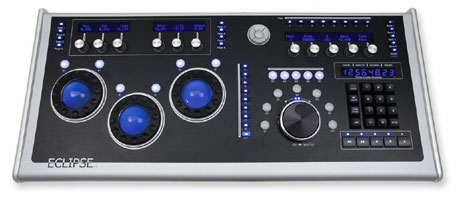

February 4, 2008
Controlling Apple's Color
From Mouse to the EclipseCX Control Surface
Review by Patrick Inhofer Finisher-In-Chief, Fini.tv
What follows is a daily diary I kept of my first experience using a JLCooper EclipseCX control surface. I'm trying to answer two questions: Is Color a better app with a control surface and will it, as some professionals claim, double my output? While doing so I'll give a review of the JL Cooper EclipseCX and how well Color interfaces with it. I'm using a diary format hoping that readers will benefit from watching me make this initial transition from color-correcting with a mouse to working on a dedicated colorist control surface.
Introduction
When Color was first
released by Apple, it made quite a splash. It's a software-based
color correction application and was designed to appeal to working
professional colorists (or those hoping, one day, to become one).
Upon introduction there was no drought of opinions on how well
Color succeeds (or doesn't) at its task. One frequent line of
comment had to do using Color with an outboard control surface -
something considered essential for professional colorists. I'd
frequently read professionals make many claims about using Color
and control surfaces:
"Color is useless without a control surface"
"Color is an entirely different app with a control surface"
"You'll grade twice as many shots with a control surface than with
a mouse"
I happen to know that the first statement is entirely false. I'm
living proof not only that Color can be mouse-driven - a career can
be made while doing so. Of the other two statements, I was never
quite sure how much those were hyperbole or fact. So I'd kept a
skeptical, though envious, eye on product developments for this
niche of outboard gear (here's a
recent roundup).
To quickly summarize, the field serving Apple's Color is
currently split between Tangent, a
manufacturer of very high-end color-correction surfaces, and
JL
Cooper, a manufacturer of a broad range of mid-priced control
surfaces. Tangent panels are more stylish and polished... but twice
the price.
Prologue: JL Cooper Eclipse CX
Since I couldn't justify the price of the Tangents I'd kept my
eye on the more affordable JL Cooper products. Specifically, I had
been in contact with JL Cooper's Danny O'Donnell who kept me
abreast of their redesigned control surface which was announced at
NAB 2007 - the Eclipse CX
(additional Eclipse info
here).But at $7,000 I had trouble justifying its cost -
having never used one. When I finally told him in September of 2007
that I was ready to order a panel, I also said I was going to order
the less expensive
older model - he countered by offering me the new EclipseCX at
wholesale, knowing that I'd eventually do a write-up such as this
(since I had previously blogged about it). With this significant
price cut the decision became a no-brainer and I quickly jumped on
his offer.
12 weeks later, just as the Christmas holiday approached, I got
an email notification that the unit had shipped.
I was joyful (understatement).
A week later, a box arrives...
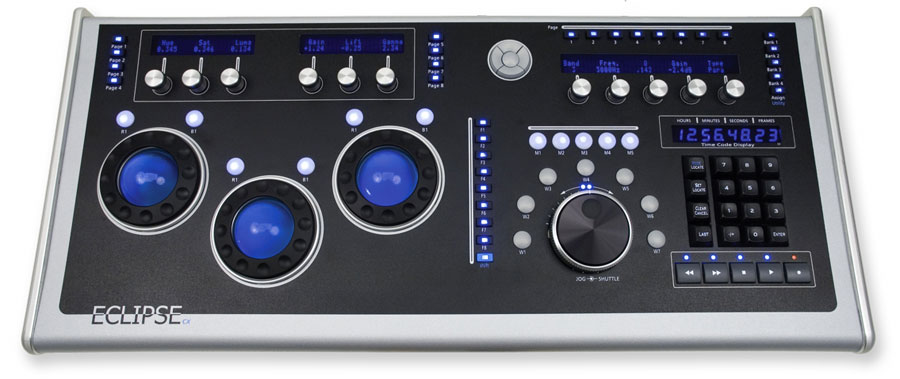
EclipseCX Colorist Control Surface
Day 0 - Arrival
It's the Thursday morning after Christmas and the "gift" I
bought myself finally arrives. I think about taking pictures of the
box (and the unboxing) - but that seems way too fan-boy. I really
should settle down. Instead I offer up a description:
The box is 5 feet tall. When I finally pull out the smaller box
containing the Eclipse, the bigger box is filled with styrofoam
peanuts - almost 4 feet deep. Ugh. It'll be a mess tossing those
things out. I remove the Eclipse from its inner protective box. At
least the peanuts worked, the panel itself is in great shape. It
feels solid. Well engineered. I sit and play with it (my wife
snickering as she walks by).
The shuttle wheel (the first thing I check out on any device that
purports to control a timeline) has a solid mechanical feel. Good
middle detent with a free spinning jog wheel in the center. No
plastic here. The keypad also feels solid, though I notice it's
missing a period button. Darn. No timecode entry shortcuts (ie:
1... = 1:00:00:00).
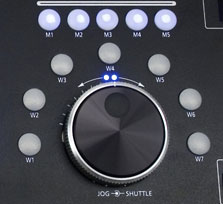
High quality shuttle/jog wheel
There are two sets of rotary knobs up top. They feel solid,
spinning cleanly but not freely. The second set don't spin, but
have slight detented clicks as you turn them. Everything here says
professional. And finally, the trackballs also move easily - but
with slight resistence. The contrast rings surrounding the
trackballs feel very very firm. Too firm. But what do I know? I've
never used one these things.

Missing a button
Overall, I'm very excited. I put it on the dining room table -
and for the next few days my eyes linger for a few moments every
time I walk by. I have a session that starts on January 2, so I'll
go in the office on January 1 to set the panel up and familiarize
myself with it. A great way to start off the New Year.
Day 1 - Setup
Traffic is a breeze getting into the city this morning. New York
must be hung over from New Years Eve. I hope this bodes well for
me.
I struggle a bit with how to physically place the Eclipse on my
desktop. The Tascam is rather large and doesn't share well. I had
half-expected this and finally get it worked out. The Eclipse
communicates over the local Ethernet network. The instructions say
it can't go into the second ethernet port, it must communicate via
the primary ethernet interface. I plug the Eclipse into the LAN.
Following the instructions I give it a unique IP address and enter
network settings by punching the numbers into the numeric keypad. I
then download and install the "Beta Ethernet" software for
customizing the panel to work with Color and FCP. After launching Color I realize I'm in trouble.
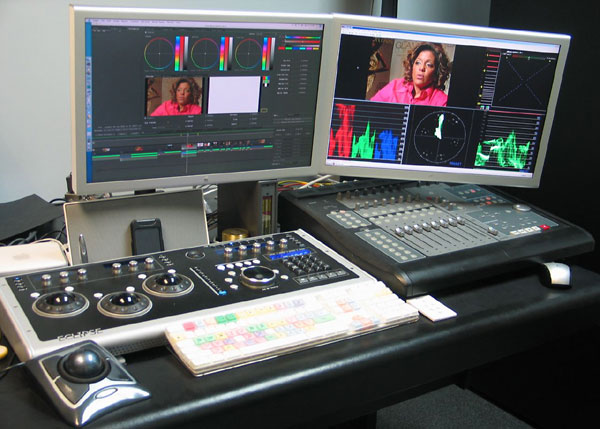
Time for a smaller audio control surface
Color isn't talking with the Eclipse. After a while I'm able to
get JL Cooper's beta software to see the panel - but within Color?
It's a no go. I remember a colorist telling me that Color natively
communicates with the panels. Clearly I'm doing something wrong in
setting up the customization software so I delete the preference
files for the beta software. I relaunch Color. I program the IP
address of the Eclipse from within Color (by this time I've changed
the IP address a half-dozen times as I try to troubleshoot).
Success!
Stupid me. If I had just gone straight into the Color I would have
saved myself 2 hours of troubleshooting. I print out the section of
the Color user manual that specifies what each of the buttons do
and I start mashing the keys, spinning the rotary knobs, working
the triple-trackballs, and playing with the transport controls. It
all seems straight-forward. Transport is about as good (maybe
better) as any I've used since my online days.

Speed is activated by the "M1" button
Two buttons have me confused: "speed++" and "Inch"
Since they're located above the transport control I'm assuming
they throttle-up and throttle-down transport. A quick test shows
that's the case.
Everything's working. It's getting past 6pm so I decide to wrap
it up and hope I can start color correcting straight-away
tomorrow.
Day 2 - Stuck in FCP
Dang. No Eclipse today.
This project has more speed changes than I've seen in years.
Nearly half the shots in this 80 minute doc are fit-to-fills. This
is almost always a no-no with Color. But the Release Notes to the
new update to FCS2 (Color 1.0.2) state that Color now correctly
handles constant speed changes. Well, this seems as good a time as
any to test that theory out. But the variable speed changes will
still have to be rendered and replaced. By the time I get this done
(as well as a half-dozen other sundry issues) and create a neat
textless timeline 6 hours have passed. We started at 2p. Time to
wrap it.
Day 3 - Mouseless (sort of)
I'm in early. We have a tight deadline and render times are
going to kill me. But first, I need to watch this show. And then
itt's starting to feel a lot like yesterday - more prep, no
Color'ing - as I break the show into 3 Reels, and test the
roundtrip for each reel. There are a few problems to fix (embedded
Motion projects, mostly). By mid-afternoon I'm ready to rock and
launch into Color to start color correcting.
The transport controls take some getting used to. Using the
"Next / Previous" buttons, I can get ahead of the software and it
doesn't take my commands. Better is: Press... pause a moment...
Press... pause a moment. I think the keyboard is faster for those
commands. Jog is much better than the keyboard. Especially with
that "Speed++" button. I can quickly jog across several shots and
get a nice sense of shot-to-shot balancing. Easier than dragging
the mouse across the timeline. The "Inch" button doesn't seem that
interesting to me. With Speed++ off the jog control feels just fine
- I don't see a need to go into "Inch" mode. The shuttle control
doesn't do anything. Guess I'll have to test that in FCP (one
day).
Color correcting with the trackballs and contrast rings is
different. Very different. I'm finding the controls feel too slow.
I go into the Color preferences and change the sensitivity from 1
to 2. Better. I do wish the contrast rings had a separate
sensitivity control. I'm finding that for big corrections I'm
really spinning those rings. And the rings are machined pretty
tight. By the end of the day I'm wondering if I like the rings at
all.
At the top of the panel on the left side are where the
"Advanced" controls in the Primary and Secondary rooms live. These
are the Gain/Gamma/Lift for the individual RGB channels. Also,
while in the Secondary room this is where you'll find controls for
Masks and the HSL qualifiers. By the end of the day I'm still not
used to quickly finding these controls, as they are listed with
generic buttons labelled "Page 1, Page 2, Page 3, etc.." But when I
do find the page I want, I find them much better than the mouse -
mostly because I can tweak two of these controls at a time.
Interestingly, you can also move the position of your masks using
the left-most trackball. But man, do you have spin that trackball!
Anyone remember Missile Command? That's what it feels like I have
to do to make that mask move... spin, spin, SPIN.
One thing conspicuously missing - the Master Gamma/Gain/Lift
controls are nowhere to be found. I think it's a mistake/bug
because three of the rotary controls are blank on Page 1. I've got
to think they're supposed to live there. Makes perfect sense,
yes?
Using the Page buttons on the top right of the panel is a real
boon. Each Page jumps to a specific room. Even better, they're
clearly labeled by an LED display. Man is that faster than the
mouse.
At the end of the day I remember what a colorist recently told
me was his favorite feature of control panels, press play - then
color correct in real-time with moving footage... and it works!
Very very nice. But it's now the end of the day. Can't explore any
further. I have gotten a decent amount of work done, even as I was
learning this new tool. Considering I started color correcting a
few hours later in the day than normal, I got done what I would
normally get done in a full day while using the mouse.
Am I faster with the control surface? I'm not sure yet. I had a
lot of material to get through and I wasn't spending as much time
on each shot as I might normally do... it's a tight deadline.
Day 4 - New Discoveries
Today I expect to put in a normal 8-hour day. I need to get
through another 20 minutes of material. This is a very cutty show
so I don't have time to get bogged down on any one shot. But there
are interview shots scattered throughout this show and I'm
determined to work in the secondaries and "re-light" those shots to
help them pop a bit more.
I'm starting to get more comfortable with the Eclipse. Bopping
between rooms using the buttons is definitely more productive. But
I can't find three commands on this panel:
- Control-G (which toggles off the entire grade to show you your
original source footage)
- The "Enable Secondary" button (a checkbox that is the bane of
all Color'ists)
- The "Inside/Outside" toggle (to quickly switch between
correcting Inside a Mask or Outside a Mask). This command I
know I saw demoed at NAB 2 years ago on the Tangent
control surface.
I'm stumped why someone would forget to assign any of these
commands... they are used constantly and there plenty of open
buttons to be assigned. I check into it... another JL Cooper user
confirms, those commands are missing. Bummer.
Today I needed to keyframe a few shots and I got to dig into the
"F" keys. I don't particularly care for these keys or their layout.
It's confusing and way too easy to delete a keyframe. Once
memorized, it's a heck of a lot easier than all the
control-clicking that needs to be done with the mouse to navigate
these keyframes. But still... Once I figure out how to do so - I'll
be remapping those.
I also discovered a new feature of the "Speed++" key. After
scrubbing through the timeline with Speed++ enabled - I forgot to
turn it off and I adjusted a rotary knob for the Red Gain... in one
full turn of the knob the gain went through the roof! Whoa... cool.
This button also effects the rotary knobs. Suddenly these things
have become a lot more natural to use. With "Speed++" engaged the
knobs move the way I want, giving me a full range of control. With
"Speed++" disengaged the rotary knobs are in a Fine-control mode.
The Eclipse has suddenly become much more powerful and natural
feeling.
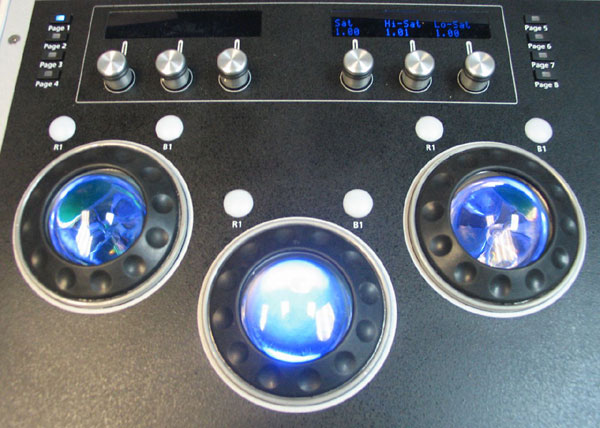
Each trackball has its own pair of reset buttons
Upper Left: The missing Master Gain/Gamma/Setup knobs
Another nice feature I'm discovering, the R1 and B1 buttons
above each of the trackballs... In the Color interface, doing a
Reset simultaneously resets both color and contrast adjustments...
together. On the Eclipse, R1 and B1 break them apart, with one
resetting color adjustments and the other resetting contrast
adjustments. On the negative side, the buttons are reversed from
the order they appear visually on the screen - making the reset
function a bit tricky. After a few hours my mind is re-wiring
itself to handle the reversal between what my eyes see and my
fingers must press.
I'm also discovering a potential hardware problem... contrast
and color adjustments seem to reset themselves randomly without me
touching anything. After an hour our two I realize it's related to
my resting a hand on the surface of the panel. A firm finger tap on
the surface confirms... too much pressure and a button gets
activated. It takes me another full day to change my habits to
prevent this from happening - but it's annoying because it's still
a problem that occurs once or twice a day.
There's another feature that I'm still not used to - copying
grades to the Memory and them pasting them back onto shots. Color
provides for 5 memorized grades. The Eclipse only supports 4
memorized grades since it uses the "Bank 1-4" buttons. There's a
fifth "Assign" button that toggles between Copy / Paste / Switch. I
haven't yet figured out "Switch" and I've already Pasted when I
should have Copied and Copied when I should have Pasted. At the
moment I'm chalking it up to a learning curve. We'll see how I fare
by the end of this job. I'm not happy that I've lost a Memory
Bank.
End of Day 4 - Intial Thoughts
I've been using this panel for a day and half now. Clearly there
are some things I really dig, others I'm not sure about, and a
potential hardware-related issue. Does Color feel like a completely
different app yet? Maybe. Am I more productive? It seems so. I
finished Reel 1 and started into Reel 2 today. About 20 minutes of
material. That's the same as the best I could accomplish in a very
long session using the mouse. More impressive because I've followed
through on the previous day's promise to make sure the interview
footage is re-lit - and I didn't loose any time doing so.
I'm still fumbling a bit, deciding when to use the mouse /
keyboard and when to use the panel. For instance, while the panel
supports the manipulation of Masks using the rotary knobs, using
the trackball for positioning is tediously slow... and once I grab
the mouse for positioning, it's much easier to use it to also
control softness and rotation.
I have been grading with moving footage most of the day. It's a
great timesaver. I'll start doing the initial grade while the
picture is playing and after it's looped once or twice I'll pause
it on what I know is a representative frame and finish the grade.
I'm almost never getting surprised anymore from the iris changing
mid-shot and me missing it.
Day 5 - Getting Back On Schedule
My deadline still looms. After color-correction I have another
two days of finishing to do. Render times have proven to be a beast
as 50% of the footage is 1080i and I'm using a Dual 2.5 G5. I
definitely need to upgrade to a Mactel next month. I'm fond of this
CPU, as it's seen me through quite a bit of growth - but now, in an
HD world, it's holding me back.
More to the point, today is Saturday - I need to get a lot of
work done today and tomorrow to make sure we stay on schedule. I'm
walking into today's session very comfortable with the control
surface. Today is showtime.
About an hour into the session I make one last major discovery:
The "Speed++" button also works with the trackballs! I don't have
the words to describe the difference it makes. Large corrections
can be made quickly. Looks can be discovered, tossed,
re-engineered, and then (turning off "Speed++") fine tuned. I
quickly jump into a Secondary, enable a mask... it is also
turbo-charged with the Speed++ control. No need to go back to the
mouse - with footage playing back I can easily reposition the mask,
adjust rotation and softness, and do it with relatively small turns
of the knobs and moves of the trackball. Excellent.
6 hours into the session and I've finished Reel 2 - including
taking time to relight all interviews. Although by halfway through
the day I'm seeing advantages of scale and can re-use many of the
saved interview grades. Still... by the end of this 8 hour day I've
color corrected almost 40 minutes of the show - nearly doubling my
best output with a mouse during a 10 hour day. Not only am I back
on schedule. I don't even need to color correct tomorrow. I'll
start rendering Reel 2 tonight and come into the office for 20
minutes on Sunday to finish rendering out Reel 1.
Even better... the contrast wheels on the Eclipse feel like
they're opening up on me. The Mids wheel is definitely spinning
much easier now. It requires less effort to turn it. I'm digging
this control much better and looking forward to when the Shadows
and Highs wheels loosen up as well. Funny though, a colorist friend
of mine took a look at the panel. He liked the tighter feel. Go
figure. I know it'll take a lot longer for the other two wheels to
free up, since the Speed++ button doesn't require me to pound on
them nearly as much as I had been.
Day 7 - Wrapping Up
I finish color correcting Reel 3 this morning. 15 minutes in a
few hours. I'm amazed. And a bit dazed. I spent some time yesterday
and this morning analyzing how I got so much done in so little
time.
Is it as I heard? With a control surface does Color feel like a
different app?
I was definitely in a different kind of zone on Saturday. I
spent far less time looking at the Color interface, instead
focusing on the reference monitor and scopes. Nor did I sacrifice
quality for that speed. The ability to play back while grading
helped keep me from having to re-do my work.
Most importantly, once I starting getting a feel for the layout
of the controls of the Pages buttons - I rarely had to look down at
the buttons, except to see if the Speed++ was turned off when I
didn't want it. And that's where the speed comes from. I could
navigate rooms, dig into otherwise buried tabs, manipulate
keyframes, and perform copy/paste operations while barely taking my
eyes off the picture.
This is the power of an outboard control surface. It allows me
to shift my attention from the interface and onto the picture. The
EclipseCX makes it feel like the Color interface has been
made tactile.
Of course, I have a total sample of one job. This is my
first show using this panel. But even if some of my speed gains are
from working quickly with a tight deadline - I haven't been working
that quickly. I'm impressed.
Conclusion
Have I mentioned that I really dig control surfaces?
The EclpiseCX follows smartly in that tradition. Leaving the
keyboard for things like text entry, it (mostly) pulls out all the
useful commands and puts my focus back where it belongs - on the
picture.
My only criticisms have to do with Color's default settings for
the JL Cooper (which is how the majority of users will interface
with it). Important keyboard commands are missing, as well as the
missing Master Gain/Gamma/Lift controls. Moving quickly between
shots using the transport buttons is too unresponsive. When copying
and pasting grades there are too few buttons chasing too many
controls (which, if you ask me, should be placed on the F keys,
using the shift button for Copy commands and unshifted for Paste).
Keyframe management is clunky and should work better if placed
elsewhere on the panel (M3, M4, M5 buttons?). Overall, I think the
Color team really should to take another look at their control
surface support for the JL Cooper and tidy things up a bit.
JL Cooper's custom software looks interesting, but is quirky.
Over the next few weeks I'll see if I can get it up and running. It
offers the promise not just of customizing it with Color, but
getting it to communicate with Final Cut Pro as well... If I manage
to get that working, definitely look for a companion
article covering those experiences.
The hardware issue with the reset buttons activating randomly
has been a hassle to deal with. I spoke to a colorist who also has
the Eclipse CX, he's not having the same hardware problem - it
looks to be a problem unique to mine... after contacting JL Cooper
they have me sending it to them for warranty repair.
Overall the Eclipse CX control surface is a thrill to use. I
don't know that Color feels like a completely different app with a
control surface - I think there's some hyperbole in that statement.
But the productivity gains are enormous. By pulling the Color
interface out from a 2D display and out onto a real world
controller a Color'ists eyes can focus where they should be - on
the reference monitor. Accessing menu items, shifting between tabs,
and changing multiple parameters simultaneously is now an exercise
in muscle memory - my eyes are watching one thing while my hands
are doing something else. That's a difficult feat when relying
solely on a mouse.
Having been uninitiated to colorist control panels, at $7,000 I was reluctant to buy into the Eclipse. I service more modestly budgeted series, docs, and indy productions. Every dollar I spend needs to scream in usefulness. The EclipseCX screams. Knowing what I know now, I would have loosened up those purse strings. A control surface is a competitive advantage. Yet, at $7,000, it's a bit painful to shell out that cash. Perhaps for someone like me, a boutique owner, it's priced above my pain point. A panel priced in the sub-$4,500 range should easily fly off the shelves. At a larger facility where several offline/online rooms are feeding a Color'ing suite, it's a must-have.
Of course, there is one downside - with these massive
productivity gains I'm going to need a bunch of new clients to fill
my schedule. With a typical session going from 2-5 days down to 1-3
days... .
In the meantime, if you know someone looking for color
correction work - my schedule has suddenly found some new holes in
it...
- pi
Patrick Inhofer is an editor, Color'ist, and nice guy. He has
18 years experience in post-production and broadcast graphics. He
is also the guy in charge of Fini.
You can praise him or flame him at articles@fini.tv.
©2008 applePi Editorial, Inc. all rights reserved
[Top]
© 2000 -2008 Ken Stone. All rights reserved. Apple, the Apple logo, Final
Cut Pro, Macintosh and Power Mac
are either registered trademarks or trademarks of Apple. Other
company and product names may be trademarks of their respective
owners.
All screen captures, images, and textual references are the property and trademark of their creators/owners/publishers.









